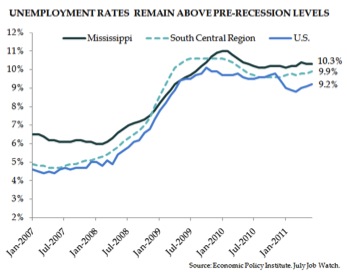Five Facts About Jobs and Unemployment
August 8th, 2011
Friday’s job report indicated that employers across the nation added 117,000 jobs in the month of July, significantly more than June’s revised growth of 46,000 jobs. With the national jobs report in mind, what trends are seen in Mississippi’s economy? Today’s post highlights five facts on Mississippi’s current employment situation and provides data on changes to unemployment and jobs over the last year.
Mississippi added jobs from May to June.
Total non-farm employment grew modestly by 1,600 jobs from May to June, an improvement from reported job losses in the previous month.
Mississippi’s overall employment sees little change over the last year.
In June 2010, Mississippi’s overall employment locked in at 1,095,000 jobs. Reports from June of this year show almost no change in the overall number of jobs available, coming in with 500 fewer jobs at 1,094,500.
Changes in employment are not equal across all sectors of Mississippi’s economy.
While the overall number of jobs has not markedly changed, some sectors are experiencing growth. Trade, business services, health & education, and leisure & hospitality have all seen employment growth over the last year. In contrast, construction employment has seen very modest gains and manufacturing and government employment both have experienced considerable job losses over the last 12 months. In the last year, local and state government employment has been hit especially hard with a loss of 8,900 jobs.
1 in 10 Mississippians continue to be unemployed and looking for work.
Over the last year, Mississippi’s unemployment rate has been above 10 percent. The state’s unemployment rate remains above pre-recession levels as many adults continue to encounter hardship in their search for employment.
Mississippi’s unemployment rate exceeds national and regional rates.
Mississippi’s unemployment rate of 10.3 percent in June remains above the rate of states in the South Central region and the nation. However, all three geographies continue to be impacted by unemployment levels well above rates from 2000 to 2007.
Click to enlarge

The employment numbers, once again, provide a strong case for a balanced approach that includes raising revenues, especially in light of a large number of jobs lost in the public sector.
Author:
Sarah Welker, Policy Analyst





